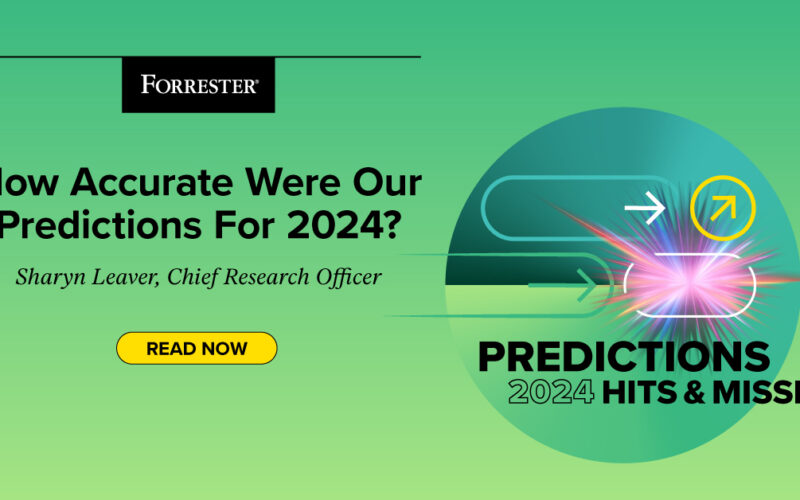Each year, the Forrester research team gathers to revisit the predictions we made the previous fall. It is, of course, a thrill to see what we’ve gotten right. But when you take the sorts of bold swings that we do every year, you inevitably sometimes miss.
As we prepare to launch our 2025 predictions (sign up here to be alerted once they’re live), here’s a look at how some of our predictions from a year ago played out.
The Hits
The prediction: Legal action over privacy protections will strike a major data provider.
The reality: This was a big hit, as not just one but two big companies recently settled claims related to sharing personal information with other firms. First, ZoomInfo agreed to pay nearly $30 million to resolve lawsuits claiming that it had used people’s names and job-related details without their consent to promote its subscription service. Soon after, Oracle agreed to pay $115 million to settle accusations of creating “digital dossiers” with people’s personal information and selling them to marketers.
Prior to this year, B2B companies hadn’t been the targets of privacy litigation or regulatory actions of the type levied against consumer brands. But as more B2B data providers shift focus from firmographics to targeting individuals, their risk increases — so instituting safeguards such as stringent consent and preference management is critical.
The prediction: Sixty percent of employees will get prompt engineering training.
The reality: In Forrester’s Digital Workplace And Employee Technology Survey, 2024, 61% percent of global information workers indicated that they’ve been through some degree of training on how to use AI for work, while 68% indicated knowledge of prompt engineering and how to use it. Since prompt engineering is the key to unlocking generative AI’s benefits, we were glad to see this prediction materialize.
The prediction: The number of green consumers will stay constant, despite climate chaos and backlash.
The reality: Despite evidence of accelerated weather-related disasters and a desire among many consumers to act sustainably, we predicted that inflation and the cost of living would heavily influence buying decisions. New Forrester data bears this out, showing that the share of “Active Green” consumers — those who pay close attention to companies’ impact on the environment and overwhelmingly choose eco-friendly items over low-cost or convenient ones — has held close to steady (it’s down 1–2 percentage points in the markets we surveyed).
Though Active Greens are a relatively small segment — fewer than one in five consumers fall into this category — our advice to companies is to recognize the cognitive dissonance that many feel when making purchases. Now is the time to innovate to deliver more environmental value for the same price, particularly as environmentally conscious younger consumers gain buying power.
The Misses
The prediction: Enterprise AI initiatives will boost productivity and creative problem-solving by 50%.
The reality: We let our bullishness on AI cloud our judgment on this one. While some processes and teams are seeing benefits from AI-powered applications, its impact right now is nowhere near 50%.
We firmly believe that AI and particularly generative AI will be a game-changer — and the idea that people would use these tools to free up headspace and creativity wasn’t wrong. But change on the scale that we predicted will take longer to unfold.
The prediction: Media titans will propel in-game advertising into the fastest-growing media channel.
The reality: Microsoft’s acquisition of Activision Blizzard last year and Sony’s rumored acquisition of Take-Two didn’t fuel the surge in in-game advertising that we expected. Despite gaming’s continued huge popularity, spending on in-game ads actually dipped in 2024 and now comprises less than 3% of digital ad spending. Concerns over ease of buying and planning in-game ads have held advertisers back thus far.
The Jury’s Still Out
The prediction: Generative AI will surface insights that dictate one in five new B2B product launches.
The reality: We expected product teams to use generative AI (genAI) for ideation and innovation, as it can help them rapidly sift through customer data for insights. That seems to be happening: One-quarter of the product management decision-makers we recently surveyed said that their organizations use genAI to identify product opportunities. Though we can’t definitively say right now that genAI is dictating product launches, conversations with our clients suggest that the momentum is swinging in this direction.
What’s In Store For 2025?
Stay tuned for our predictions for the coming year, which will span topics including automation, the future of work, customer experience, business buyers, and many more. (If you’re a Forrester client, check out our newly published artificial intelligence and tech leadership Predictions reports.) We look forward to making and publishing these bold calls each year to help you anticipate what’s ahead. Sign up to get alerted as soon as Predictions 2025 goes live.
Source link
lol

